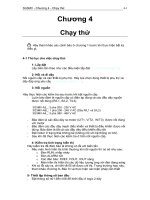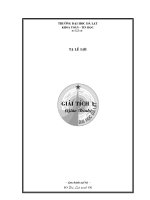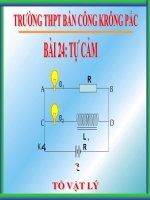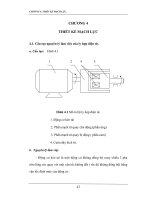Tài liệu Bài giải mạch P4 ppt
Bạn đang xem bản rút gọn của tài liệu. Xem và tải ngay bản đầy đủ của tài liệu tại đây (2.35 MB, 79 trang )
Chapter 4, Solution 1.
i i
o
5
Ω
8
Ω
1
Ω
+
−
1 V
3 Ω
Ω=+ 4)35(8 ,
5
1
41
1
i =
+
=
===
10
1
i
2
1
i
o
0.1A
Chapter 4, Solution 2.
,3)24(6 Ω=+ A
2
1
i
21
==i
,
4
1
i
2
1
i
1o
== ==
oo
i2v 0.5V
5
Ω
4
Ω
i
2
8
Ω
i
1
i
o
6
Ω
1 A
2 Ω
If i
s
= 1µA, then v
o
= 0.5µV
Chapter 4, Solution 3.
R
+
v
o
−
3R
i
o
3R
3R
R
+
−
3R
+
−
1 V
1.5R
V
s
(b)
(a)
(a)
We transform the Y sub-circuit to the equivalent
∆
.
,R
4
3
R
4
R3
R3R
2
== R
2
3
R
4
3
R
4
3
=+
2
v
v
s
o
= independent of R
i
o
= v
o
/(R)
When v
s
= 1V, v
o
= 0.5V, i
o
= 0.5A
(b)
When v
s
= 10V, v
o
= 5V, i
o
= 5A
(c)
When v
s
= 10V and R = 10Ω,
v
o
= 5V, i
o
= 10/(10) = 500mA
Chapter 4, Solution 4.
If I
o
= 1, the voltage across the 6Ω resistor is 6V so that the current through the 3Ω
resistor is 2A.
+
v
1
−
3A
I
s
2
Ω
4 Ω
i
1
3A
1A
I
s
2A
6
Ω
4
Ω
3 Ω
2 Ω 2
Ω
(a)
(b)
Ω= 263
, v
o
= 3(4) = 12V, .A3
4
v
o
1
==
i
Hence I
s
= 3 + 3 = 6A
If I
s
= 6A I
o
= 1
I
s
= 9A I
o
= 6/(9) = 0.6667A
Chapter 4, Solution 5.
If v
o
= 1V, V21
3
1
V
1
=+
=
3
10
v
3
2
2V
1s
=+
=
If v
s
=
3
10
v
o
= 1
Then v
s
= 15 v
o
= =15x
10
3
4.5V
v
o
3
Ω
2 Ω
+
−
6
Ω
6
Ω
6 Ω
v
1
V
s
Chapter 4, Solution 6
Let
s
T
T
oT
V
RR
R
V
RR
RR
RRR
132
32
32
then ,//
+
=
+
==
133221
32
1
32
32
32
32
1
RRRRRR
RR
R
RR
RR
RR
RR
RR
R
V
V
k
T
T
s
o
++
=
+
+
+
=
+
==
Chapter 4, Solution 7
We find the Thevenin equivalent across the 10-ohm resistor. To find V
Th
, consider the
circuit below.
3V
x
5Ω 5
Ω
+
+
4V 15
Ω
V
Th
- 6
Ω
-
+ V
x -
From the figure,
V3)4(
515
15
,0 =
+
==
Thx
VV
To find R
Th,
consider the circuit below:
3V
x
5
Ω 5
Ω
V
1
V
2
+
4V 15
Ω
1A
- 6
Ω
+ V
x
-
At node 1,
12
2111
73258616,
515
3
5
4
VVxV
VVV
V
V
xx
−=→==
−
++=
−
(1)
At node 2,
950
5
31
21
21
−=→=
−
++ VV
VV
V
x
(2)
Solving (1) and (2) leads to V
2
= 101.75 V
mW 11.22
75.1014
9
4
,75.101
1
2
max
2
===Ω==
xR
V
p
V
R
Th
Th
Th
Chapter 4, Solution 8.
Let i = i
1
+ i
2
,
where i
1
and i
L
are due to current and voltage sources respectively.
6
Ω
i
1
+
−
20V
i
2
5 A
4 Ω 6 Ω
4 Ω
(a)
(b)
i
1
= ,A3)5(
46
6
=
+
A2
46
20
2
=
+
=i
Thus i = i
1
+ i
2
= 3 + 2 = 5A
Chapter 4, Solution 9.
Let
i
2
x
1
xx
ii +=
where
i is due to 15V source and i is due to 4A source,
1
x
2
x
12
Ω
-4A
40Ω 10
Ω
i
x2
40
Ω
i
10 Ω
i
x1
12 Ω
+
−
15V
(a)
(b)
For i
x1
, consider Fig. (a).
10||40 = 400/50 = 8 ohms, i = 15/(12 + 8) = 0.75
i
x1
= [40/(40 + 10)]i = (4/5)0.75 = 0.6
For i
x2
, consider Fig. (b).
12||40 = 480/52 = 120/13
i
x2
= [(120/13)/((120/13) + 10)](-4) = -1.92
i
x
= 0.6 – 1.92 = -1.32 A
p = vi
x
= i
x
2
R = (-1.32)
2
10 = 17.43 watts
Chapter 4, Solution 10.
Let v
ab
= v
ab1
+ v
ab2
where v
ab1
and v
ab2
are due to the 4-V and the 2-A sources
respectively.
+
v
ab2
−
10
Ω
+
−
3v
ab2
2 A
10 Ω
+
−
+
v
ab1
−
+ −
3v
ab1
4V
(a) (b)
For v
ab1
, consider Fig. (a). Applying KVL gives,
- v
ab1
– 3 v
ab1
+ 10x0 + 4 = 0, which leads to v
ab1
= 1 V
For v
ab2
, consider Fig. (b). Applying KVL gives,
-
v
ab2
– 3v
ab2
+ 10x2 = 0, which leads to v
ab2
= 5
v
ab
= 1 + 5 = 6 V
Chapter 4, Solution 11.
Let i = i
1
+ i
2
, where i
1
is due to the 12-V source and i
2
is due to the 4-A source.
12V
4A
2Ω 2
Ω
i
x2
6Ω
4A
3
Ω
2Ω
i
2
3
Ω
i
o
(a)
2
Ω
i
1
6
Ω
+
−
(b)
For i
1
, consider Fig. (a).
2||3 = 2x3/5 = 6/5, i
o
= 12/(6 + 6/5) = 10/6
i
1
= [3/(2 + 3)]i
o
= (3/5)x(10/6) = 1 A
For i
2
, consider Fig. (b), 6||3 = 2 ohm, i
2
= 4/2 = 2 A
i = 1 + 2 =
3 A
Chapter 4, Solution 12.
Let v
o
= v
o1
+ v
o2
+ v
o3
, where v
o1
, v
o2
, and v
o3
are due to the 2-A, 12-V, and 19-V
sources respectively. For v
o1
, consider the circuit below.
5
Ω
5
Ω
+ v
o1
−
i
o
2A
2A
3Ω
4
Ω
6Ω 12
Ω
5 Ω
+ v
o1
−
6||3 = 2 ohms, 4||12 = 3 ohms. Hence,
i
o
= 2/2 = 1, v
o1
= 5io = 5 V
For v
o2
, consider the circuit below.
6 Ω 5 Ω 4
Ω
6
Ω
5 Ω
+ v
o2
−
3
Ω
3 Ω
+
v
1
−
+
−
12V
+ v
o2
−
12
Ω
+
−
3 Ω
12V
3||8 = 24/11, v
1
= [(24/11)/(6 + 24/11)]12 = 16/5
v
o2
= (5/8)v
1
= (5/8)(16/5) = 2 V
For v
o3
, consider the circuit shown below.
4 Ω 5 Ω 5
Ω
4 Ω
2
Ω
+ v
o3
−
12
Ω
+
v
2
−
+
−
19V
+
−
19V
6Ω
+ v
o3
−
12 Ω
3 Ω
7||12 = (84/19) ohms, v
2
= [(84/19)/(4 + 84/19)]19 = 9.975
v = (-5/7)v2 = -7.125
v
o
= 5 + 2 – 7.125 = -125 mV
,
Chapter 4, Solution 13
Let
iiii
321o
+
+
=
where i
1
, i
2
, and i
3
are the contributions to i
o
due to 30-V, 15-V, and 6-mA sources
respectively. For i
1
, consider the circuit below.
1 kΩ 2 k
Ω
3 k
Ω
+ i
1
30V
- 4 k
Ω
5 k
Ω
3//5 = 15/8 = 1.875 kohm, 2 + 3//5 = 3.875 kohm, 1//3.875 = 3.875/4.875 = 0.7949
kohm. After combining the resistors except the 4-kohm resistor and transforming the
voltage source, we obtain the circuit below.
i
1
30 mA
4 k
Ω
0.7949 k
Ω
Using current division,
mA 4.973mA)30(
7949.4
7949.0
1
==i
For i
2
, consider the circuit below.
1 k
Ω 2 k
Ω
3 k
Ω
i
2 -
15V
4 k
Ω
5 k
Ω
+
After successive source transformation and resistance combinations, we obtain the circuit
below:
2.42mA
i
2
4 k
Ω
0.7949 k
Ω
Using current division,
mA 4012.0mA)42.2(
7949.4
7949.0
2
−=−=i
For i
3
, consider the circuit below.
6mA
1 k
Ω 2 k
Ω
3 k
Ω
i
3
4 k
Ω
5 k
Ω
After successive source transformation and resistance combinations, we obtain the circuit
below:
3.097mA
i
3
4 k
Ω
0.7949 k
Ω
mA 5134.0mA)097.3(
7949.4
7949.0
3
−=−=i
Thus,
mA 058.4
321
=++= iiii
o
Chapter 4, Solution 14.
Let v
o
= v
o1
+ v
o2
+ v
o3
, where v
o1
, v
o2
, and v
o3
, are due to the 20-V, 1-A, and 2-A
sources respectively. For v
o1
, consider the circuit below.
6 Ω
20V
+
−
+
v
o1
−
4 Ω
2 Ω
3
Ω
6||(4 + 2) = 3 ohms, v
o1
= (½)20 = 10 V
For v
o2
, consider the circuit below.
6 Ω 6
Ω
1A
2 Ω
4
Ω
+
v
o2
−
4V
−
+
2 Ω
4 Ω
3
Ω
+
v
o2
−
3 Ω
3||6 = 2 ohms, v
o2
= [2/(4 + 2 + 2)]4 = 1 V
For v
o3
, consider the circuit below.
6 Ω
3
Ω
−
v
o3
+
3
Ω
2A
2 Ω
4 Ω
3
Ω
+
v
o3
−
2A
6||(4 + 2) = 3, v
o3
= (-1)3 = -3
v
o
= 10 + 1 – 3 = 8 V
Chapter 4, Solution 15.
Let i = i
1
+ i
2
+ i
3
, where i
1
, i
2
, and i
3
are due to the 20-V, 2-A, and 16-V sources. For
i
1
, consider the circuit below.
i
o
4
Ω
3
Ω
i
1
1
Ω
+
−
20V
2 Ω
4||(3 + 1) = 2 ohms, Then i
o
= [20/(2 + 2)] = 5 A, i
1
= i
o
/2 = 2.5 A
For i
3
, consider the circuit below.
2||(1 + 3) = 4/3, v
o
’ = [(4/3)/((4/3) + 4)](-16) = -4
i
3
= v
o
’/4 = -1
For i
2
, consider the circuit below.
3Ω
i
2
1 Ω
(
4/3
)
Ω
3Ω
i
2
1 Ω
2A
4
Ω
+
v
o
’
−
4
Ω
3
Ω
i
3
1
Ω
2 Ω
−
+
16V
2A
2 Ω
2||4 = 4/3, 3 + 4/3 = 13/3
Using the current division principle.
i
2
= [1/(1 + 13/2)]2 = 3/8 = 0.375
i = 2.5 + 0.375 - 1 =
1.875 A
p = i
2
R = (1.875)
2
3 = 10.55 watts
Chapter 4, Solution 16.
Let i
o
= i
o1
+ i
o2
+ i
o3
, where i
o1
, i
o2
, and i
o3
are due to
the 12-V, 4-A, and 2-A sources. For i
o1
, consider the circuit below.
5
Ω
i
o1
10
Ω
4
Ω
+
−
3
Ω
2
Ω
12V
10||(3 + 2 + 5) = 5 ohms, i
o1
= 12/(5 + 4) = (12/9) A
For i
o2
, consider the circuit below.
i
o2
i
1
4A
10
Ω
2
Ω
4Ω
3
Ω
5
Ω
2 + 5 + 4||10 = 7 + 40/14 = 69/7
i
1
= [3/(3 + 69/7)]4 = 84/90, i
o2
=[-10/(4 + 10)]i
1
= -6/9
For i
o3
, consider the circuit below.
i
2
2 A
i
o3
10
Ω
5 Ω 4
Ω
3
Ω
2
Ω
3 + 2 + 4||10 = 5 + 20/7 = 55/7
i
2
= [5/(5 + 55/7)]2 = 7/9, i
o3
= [-10/(10 + 4)]i
2
= -5/9
i
o
= (12/9) – (6/9) – (5/9) = 1/9 = 111.11 mA
Chapter 4, Solution 17.
Let v
x
= v
x1
+ v
x2
+ v
x3
, where v
x1
,v
x2
, and v
x3
are due to the 90-V, 6-A, and 40-V
sources. For v
x1
, consider the circuit below.
30 Ω 10
Ω
20
Ω
12 Ω
+ −
v
x1
10
Ω
20
Ω
3 A
i
o
30
Ω
+
−
v
x1
60 Ω
+
−
90V
20||30 = 12 ohms, 60||30 = 20 ohms
By using current division,
i
o
= [20/(22 + 20)]3 = 60/42, v
x1
= 10i
o
= 600/42 = 14.286 V
For v
x2
, consider the circuit below.
i
o
’
20
Ω
30
Ω
i
o
’
6A
60 Ω 30 Ω
10 Ω
+ −
v
x2
+ v
x2
−
6A
20
Ω
12
Ω
10
Ω
i
o
’ = [12/(12 + 30)]6 = 72/42, v
x2
= -10i
o
’ = -17.143 V
For v
x3
, consider the circuit below.
20
Ω
+ −
v
x3
7.5Ω
4A
i
o
”
+
−
40V
30 Ω 30 Ω
+ −
v
x3
60 Ω
10
Ω
10 Ω 10
Ω
i
o
” = [12/(12 + 30)]2 = 24/42, v
x3
= -10i
o
” = -5.714
v
x
= 14.286 – 17.143 – 5.714 = -8.571 V
Chapter 4, Solution 18.
Let i
x
= i
1
+ i
2
, where i
1
and i
2
are due to the 10-V and 2-A sources respectively. To
obtain i
1
, consider the circuit below.
2 Ω
+
−
10i
1
i
1
2 Ω
+
−
10V
1
Ω
i
1
4
Ω
5i
1
1 Ω
+
−
4 Ω
10V
-10 + 10i
1
+ 7i
1
= 0, therefore i
1
= (10/17) A
For i
2
, consider the circuit below.
i
o
+ −
10i
2
2
Ω
+
−
2V
1
Ω
i
o
i
2
1 Ω
4
Ω
2 Ω
10i
2
2 A
+ −
4
Ω
-2 + 10i
2
+ 7i
o
= 0, but i
2
+ 2 = i
o
. Hence,
-2 + 10i
2
+7i
2
+ 14 = 0, or i
2
= (-12/17) A
v
x
= 1xi
x
= 1(i
1
+ i
2
) = (10/17) – (12/17) = -2/17 = -117.6 mA
Chapter 4, Solution 19.
Let v
x
= v
1
+ v
2
, where v
1
and v
2
are due to the 4-A and 6-A sources respectively.
i
x
v
1
i
x
v
2
+
v
2
−
+
v
1
−
8 Ω 2
Ω
4i
x
6 A
−
+
8
Ω
2 Ω
4i
x
4 A
− +
(a) (b)
To find v
1
, consider the circuit in Fig. (a).
v
1
/8 = 4 + (-4i
x
– v
1
)/2
But, -i
x
= (-4i
x
– v
1
)/2 and we have -2i
x
= v
1
. Thus,
v
1
/8 = 4 + (2v
1
– v
1
)/8, which leads to v
1
= -32/3
To find v
2
, consider the circuit shown in Fig. (b).
v
2
/2 = 6 + (4i
x
– v
2
)/8
But i
x
= v
2
/2 and 2i
x
= v
2
. Therefore,
v
2
/2 = 6 + (2v
2
– v
2
)/8 which leads to v
2
= -16
Hence, vx = –(32/3) – 16 =
-26.67 V
Chapter 4, Solution 20.
Transform the voltage sources and obtain the circuit in Fig. (a). Combining the 6-ohm
and 3-ohm resistors produces a 2-ohm resistor (6||3 = 2). Combining the 2-A and 4-A
sources gives a 6-A source. This leads to the circuit shown in Fig. (b).
i
6Ω
4A
3
Ω
2Ω
i
6A
2
Ω
2
Ω
2A
(a) (b)
From Fig. (b), i = 6/2 =
3 A
Chapter 4, Solution 21.
To get i
o
, transform the current sources as shown in Fig. (a).
6 Ω
+
v
o
−
2 A
3
Ω
i
6
Ω
2 A
+
−
6V
i
o
3 Ω
+
−
12V
(a) (b)
From Fig. (a), -12 + 9i
o
+ 6 = 0, therefore i
o
= 666.7 mA
To get v
o
, transform the voltage sources as shown in Fig. (b).
i = [6/(3 + 6)](2 + 2) = 8/3
v
o
= 3i = 8 V
Chapter 4, Solution 22.
We transform the two sources to get the circuit shown in Fig. (a).
5
Ω
5
Ω
10V
4
Ω
10
Ω
2A
i
10
Ω
1A
2A
(a)
10
Ω
4
Ω
−
+
(b)
We now transform only the voltage source to obtain the circuit in Fig. (b).
10||10 = 5 ohms, i = [5/(5 + 4)](2 – 1) = 5/9 =
555.5 mA
Chapter 4, Solution 23
If we transform the voltage source, we obtain the circuit below.
8
Ω
10
Ω
6
Ω
3
Ω
5A
3A
3//6 = 2-ohm. Convert the current sources to voltages sources as shown below.
10
8Ω
Ω
2
Ω
+ +
10V
30V -
-
Applying KVL to the loop gives
A 10)2810(1030 =→=++++− II
W8
2
=== RIVIp
Chapter 4, Solution 24
Convert the current source to voltage source.
16
Ω 1
Ω
4
Ω
+ 5
Ω
+
48 V
10
Ω
V
o
-
+
-
12 V
-
Combine the 16-ohm and 4-ohm resistors and convert both voltages sources to current
Sources. We obtain the circuit below.
1
Ω
2.4A 20 5Ω
Ω
2.4A 10 Ω
Combine the resistors and current sources.
20//5 = (20x5)/25 = 4
, 2.4 + 2.4 = 4.8 A Ω
Convert the current source to voltage source. We obtain the circuit below.
4 Ω 1
Ω
+ +
19.2V V
o
10
Ω
- -
Using voltage division,
8.12)2.19(
1410
10
=
++
=
o
V V
Chapter 4, Solution 25.
Transforming only the current source gives the circuit below.
12V
30 V
5
Ω
9
Ω
18 V
+
−
v
o
4 Ω
2
Ω
i
+
−
−
+
−
+
+
−
30 V
Applying KVL to the loop gives,
(4 + 9 + 5 + 2)i – 12 – 18 – 30 – 30 = 0
20i = 90 which leads to i = 4.5
v
o
= 2i = 9 V
Chapter 4, Solution 26.
Transform the voltage sources to current sources. The result is shown in Fig. (a),
30||60 = 20 ohms, 30||20 = 12 ohms
10
Ω
+
+ v
x
−
12
Ω
10
Ω
−
96V
i
20
Ω
+
−
60V
20
Ω
3A
2A
+ v
x
−
60
Ω
30
Ω
6A
(a)
30Ω
(b)
Combining the resistors and transforming the current sources to voltage sources, we
obtain the circuit in Fig. (b). Applying KVL to Fig. (b),
42i – 60 + 96 = 0, which leads to i = -36/42
v
x
= 10i = -8.571 V
Chapter 4, Solution 27.
Transforming the voltage sources to current sources gives the circuit in Fig. (a).
10||40 = 8 ohms
Transforming the current sources to voltage sources yields the circuit in Fig. (b).
Applying KVL to the loop,
-40 + (8 + 12 + 20)i + 200 = 0 leads to i = -4
v
x
12i = -48 V
12
Ω
+ v
x
−
10Ω 20
Ω
40
Ω
5A
8A 2A
(a)
8
Ω
12
Ω
20
Ω
+
−
+
−
+ v
x
−
40V 200V
i
(b)
Chapter 4, Solution 28.
Transforming only the current sources leads to Fig. (a). Continuing with source
transformations finally produces the circuit in Fig. (d).
3
Ω
i
o
10 V
+ −
12 V
+
−
+
−
4 Ω 5
Ω
2
Ω
10Ω
12 V
(a)
4
Ω
5 Ω
i
o
+
−
12V
4
Ω
+
−
11V
i
o
i
o
+
−
12V
10Ω
4 Ω
2.2A
10Ω
i
o
+
−
22 V
(b)
+
−
12V
10
Ω
10
Ω
(c)
(d)
Applying KVL to the loop in fig. (d),
-12 + 9i
o
+ 11 = 0, produces i
o
= 1/9 = 111.11 mA
Chapter 4, Solution 29.
Transform the dependent voltage source to a current source as shown in
Fig. (a). 2||4 = (4/3) k ohms
4
k
Ω
It is clear that i = 3 mA which leads to v
o
= 1000i = 3 V
If the use of source transformations was not required for this problem, the actual answer
could have been determined by inspection right away since the only current that could
have flowed through the 1 k ohm resistor is 3 mA.
Chapter 4, Solution 30
Transform the dependent current source as shown below.
i
x
24
Ω
60
Ω
10
Ω
+ +
12V 30
Ω
7i
x
- -
+
v
o
−
1
k
Ω
+
v
o
−
3 mA
2v
o
(
4/3
)
k
Ω
(b)
i
−
+
3 mA
1.5v
o
1
k
Ω
2
k
Ω
(a)
Combine the 60-ohm with the 10-ohm and transform the dependent source as shown
below.
i
x
24
Ω
+
12V 30
Ω
70
Ω
0.1i
x
-
Combining 30-ohm and 70-ohm gives 30//70 = 70x30/100 = 21-ohm. Transform the
dependent current source as shown below.
i
x
24
Ω
21
Ω
+ +
12V 2.1i
x
- -
Applying KVL to the loop gives
mA 8.254
1.47
12
01.21245 ==→=+−
xxx
iii
Chapter 4, Solution 31.
Transform the dependent source so that we have the circuit in
Fig. (a). 6||8 = (24/7) ohms. Transform the dependent source again to get the circuit in
Fig. (b).
3
Ω
6
Ω
+
−
v
x
+
−
8
Ω
v
x
/3
12V
(a)
(
24/7
)
Ω
3
Ω
i
+
+
−
v
x
+
−
(8/7)v
x
12V
(b)
From Fig. (b),
v
x
= 3i, or i = v
x
/3.
Applying KVL,
-12 + (3 + 24/7)i + (24/21)v
x
= 0
12 = [(21 + 24)/7]v
x
/3 + (8/7)v
x
, leads to v
x
= 84/23 = 3.625 V
Chapter 4, Solution 32.
As shown in Fig. (a), we transform the dependent current source to a voltage source,
15
Ω
10
Ω
−
+
50
Ω
+
−
5i
x
40
Ω
60V
(a)
15
Ω
i
x
50
Ω
50
Ω
(b)
+
−
i
x
25
Ω
+
−
60V
2.5i
x
15
Ω
−
60V
0.1i
x
(c)









